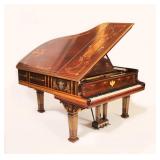View current listings by this company
The Evelyn Nesbit and Isaac D. Fletcher Steinway Model A Grand Piano
Listing ID#: 778776
| Sale Location |
|---|
|
New York, NY 10035 |
| Sale Dates and Times |
|---|
|
Bidding Starts: Friday May 2, 10:00 AM Bidding Ends: Thursday May 15, 10:00 AM |
| Sale Type |
|---|
 Online Auction
VIEW ONLINE CATALOG Online Auction
VIEW ONLINE CATALOG |

| Company Information |
|---|
|
iGavel Auctions Contact: Lark Mason Phone: 212-289-5588 Email: tech@igavelauctions.com Website: www.igavelauctions.com EstateSale.com ID#: 5138 View company information and listings |
Free Email Notifications
Sign up for the EstateSale.com email notifications and we will let you know about sales in your area! You may set up alerts by area (zip and radius), keywords, and by company. It is FREE and only takes a few seconds to sign up.
| Listing Information |
|---|
|
Piano available for viewing by appointment, please call (212) 289-5524 or email niki@larkmasonassociates.com
This Steinway fancy painted empire Model A grand piano, serial number 88495 was made in New York in 1897. It was painted by Arthur Edward Blackmore (New York / England 1854-1921), and his signature and the date are visible on the panel at the front of the cover. The piano was purchased from Steinway by the American industrialist, businessman, art collector, and museum benefactor Isaac D. Fletcher, for his mansion at the corner of East 79th Street and Fifth Avenue in 1898. The mansion is known today as the Harry F. Sinclair House, which houses the Ukrainian Institute of America. |
|
Photo Gallery
|
|||||
|---|---|---|---|---|---|
|
|||||




